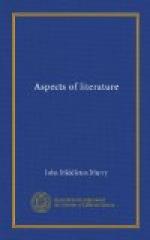Still, the ideal society is sufficiently remote for us to disregard it, and we shall say that the principle of art for art’s sake contains an element of truth when it is opposed to those who would inflict upon art the values of science, of metaphysics, or of a morality of mere convention. We shall also say that the principle of art for art’s sake needs to be understood and interpreted very differently. Its implications are tremendous. Art is autonomous, and to be pursued for its own sake, precisely because it comprehends the whole of human life; because it has reference to a more perfectly human morality than other activity of man; because, in so far as it is truly art, it is indicative of a more comprehensive and unchallengeable harmony in the spirit of man. It does not demand impossibilities, that man should be at one with the universe or in tune with the infinite; but it does envisage the highest of all attainable ideals, that man should be at one with himself, obedient to his own most musical law.
Thus art reveals to us the principle of its own governance. The function of criticism is to apply it. Obviously it can be applied only by him who has achieved, if not the actual aesthetic ideal in life, at least a vision and a sense of it. He alone will know that the principle he has to elucidate and apply is living, organic. It is indeed the very principle of artistic creation itself. Therefore he will approach what claims to be a work of art first as a thing in itself, and seek with it the most intimate and immediate contact in order that he may decide whether it too is organic and living. He will be untiring in his effort to refine his power of discrimination by the frequentation of the finest work of the past, so that he may be sure of himself when he decides, as he must, whether the object before him is the expression of an aesthetic intuition at all. At the best he is likely to find that it is mixed and various; that fragments of aesthetic vision jostle with unsubordinated intellectual judgments.
But, in regarding the work of art as a thing in itself, he will never forget the hierarchy of comprehension, that the active ideal of art is indeed to see life steadily and see it whole, and that only he has a claim to the title of a great artist whose work manifests an incessant growth from a merely personal immediacy to a coherent and all-comprehending attitude to life. The great artist’s work is in all its parts a revelation of the ideal as a principle of activity in human life. As the apprehension of the ideal




